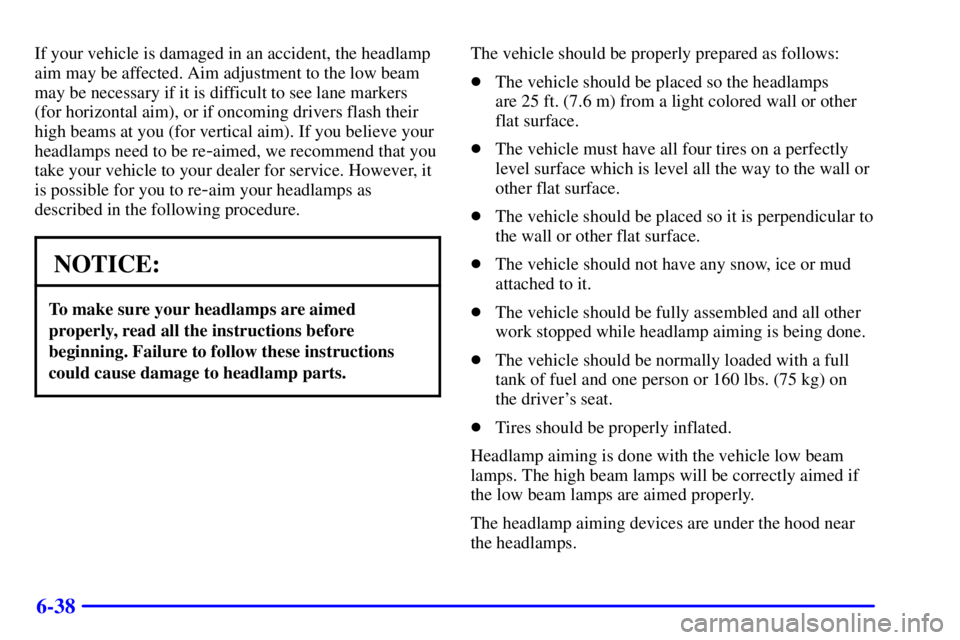Page 239 of 427

4-17
Here are some tips on night driving.
�Drive defensively.
�Don't drink and drive.
�Adjust your inside rearview mirror to reduce the
glare from headlamps behind you.
�Since you can't see as well, you may need to
slow down and keep more space between you
and other vehicles.
�Slow down, especially on higher speed roads. Your
headlamps can light up only so much road ahead.
�In remote areas, watch for animals.
�If you're tired, pull off the road in a safe place
and rest.
No one can see as well at night as in the daytime. But as
we get older these differences increase. A 50
-year-old
driver may require at least twice as much light to see the
same thing at night as a 20
-year-old.
What you do in the daytime can also affect your night
vision. For example, if you spend the day in bright
sunshine you are wise to wear sunglasses. Your eyes will
have less trouble adjusting to night. But if you're
driving, don't wear sunglasses at night. They may cut
down on glare from headlamps, but they also make a lot
of things invisible.You can be temporarily blinded by approaching
headlamps. It can take a second or two, or even several
seconds, for your eyes to readjust to the dark. When
you are faced with severe glare (as from a driver who
doesn't lower the high beams, or a vehicle with
misaimed headlamps), slow down a little. Avoid staring
directly into the approaching headlamps.
Keep your windshield and all the glass on your vehicle
clean
-- inside and out. Glare at night is made much
worse by dirt on the glass. Even the inside of the glass
can build up a film caused by dust. Dirty glass makes
lights dazzle and flash more than clean glass would,
making the pupils of your eyes contract repeatedly.
Remember that your headlamps light up far less of a
roadway when you are in a turn or curve. Keep your
eyes moving; that way, it's easier to pick out dimly
lighted objects. Just as your headlamps should be
checked regularly for proper aim, so should your eyes
be examined regularly. Some drivers suffer from night
blindness
-- the inability to see in dim light -- and
aren't even aware of it.
Page 333 of 427

6-38
If your vehicle is damaged in an accident, the headlamp
aim may be affected. Aim adjustment to the low beam
may be necessary if it is difficult to see lane markers
(for horizontal aim), or if oncoming drivers flash their
high beams at you (for vertical aim). If you believe your
headlamps need to be re
-aimed, we recommend that you
take your vehicle to your dealer for service. However, it
is possible for you to re
-aim your headlamps as
described in the following procedure.
NOTICE:
To make sure your headlamps are aimed
properly, read all the instructions before
beginning. Failure to follow these instructions
could cause damage to headlamp parts.
The vehicle should be properly prepared as follows:
�The vehicle should be placed so the headlamps
are 25 ft. (7.6 m) from a light colored wall or other
flat surface.
�The vehicle must have all four tires on a perfectly
level surface which is level all the way to the wall or
other flat surface.
�The vehicle should be placed so it is perpendicular to
the wall or other flat surface.
�The vehicle should not have any snow, ice or mud
attached to it.
�The vehicle should be fully assembled and all other
work stopped while headlamp aiming is being done.
�The vehicle should be normally loaded with a full
tank of fuel and one person or 160 lbs. (75 kg) on
the driver's seat.
�Tires should be properly inflated.
Headlamp aiming is done with the vehicle low beam
lamps. The high beam lamps will be correctly aimed if
the low beam lamps are aimed properly.
The headlamp aiming devices are under the hood near
the headlamps.
Page 364 of 427
6-69
Minifuse Usage
1 Not Used
2 Accessory
3 Windshield Wipers
4 Not Used
5 Headlamp Low Beam LeftMinifuse Usage
6 Headlamp Low Beam Right
7 Spare
8 Powertrain Control
Module Battery
9 Headlamp High Beam Right
10 Headlamp High Beam Left
11 Ignition 1
12 Not Used
13 Transaxle
14 Cruise Control
15 Direct Ignition System
16 Injector Bank #2
17 Not Used
18 Not Used
19 Powertrain Control
Module Ignition
Page 365 of 427
6-70
Minifuse Usage
20 Oxygen Sensor
21 Injector Bank #1
22 Auxiliary Power
23 Cigar Lighter
24 Fog Lamps/Daytime
Running Lamps
25 Horn
26 Air Conditioning Clutch
Micro Relay Usage
27 Headlamp High Beam
28 Headlamp Low Beam
29 Fog Lamps
30 Daytime Running LampsMicro Relay Usage
31 Horn
32 Air Conditioning Clutch
33 HVAC Solenoid
Mini Relay Usage
34 Accessory
35 Air Pump
36 Starter 1
37 Cooling Fan Secondary
38 Ignition 1
39 Cooling Fan Series/Parallel
40 Cooling Fan Primary
Page 372 of 427

6-77
Replacement Bulbs
Front Outside Lamps Bulb Number
Parking/Turn Lamps 3157. . . . . . . . . . . . . . . . . . . . .
Headlamp
Low Beam 9006. . . . . . . . . . . . . . . . . . . . . . . . . . . .
High Beam 9005. . . . . . . . . . . . . . . . . . . . . . . . . . .
Rear Outside Lamps Bulb Number
Taillamps 3057. . . . . . . . . . . . . . . . . . . . . . . . . . . . . .
Back
-Up Lamps 3057. . . . . . . . . . . . . . . . . . . . . . . . .
Stoplamps 3057. . . . . . . . . . . . . . . . . . . . . . . . . . . . . .
Turn 3157. . . . . . . . . . . . . . . . . . . . . . . . . . . . . . . . . .
For any bulb not listed here contact your dealer.
Capacities and Specifications
The following approximate capacities are given in
English and metric conversions. Please refer to
ªRecommended Fluids and Lubricantsº in the Index
for more information.
Capacities
Automatic Transaxle 7.4 quarts (7.0 L). . . . . . . . . . .
Engine Cooling System 10.0 quarts (9.5 L). . . . . . . .
Engine Oil with Filter 4.5 quarts (4.3 L). . . . . . . . . .
Fuel Tank 18.5 U.S. gallons (70.0 L). . . . . . . . . . . . .
All capacities are approximate. When adding, be sure
to fill to the appropriate level, as recommended in
this manual.
Wheel Nut Torque
100 lb-ft (140 N´m)
Engine Specifications
VIN Engine Code
3800 V6 Engine (L36) K. . . . . . . . . . . . . . . . . . . . .
3800 V6 Supercharged Engine (L67) 1. . . . . . . . . .
TypeV6 . . . . . . . . . . . . . . . . . . . . . . . . . . . . . . . . . . . .
Displacement3.8L . . . . . . . . . . . . . . . . . . . . . . . . . . .
Firing Order1
-6-5-4-3-2 . . . . . . . . . . . . . . . . . . . . .